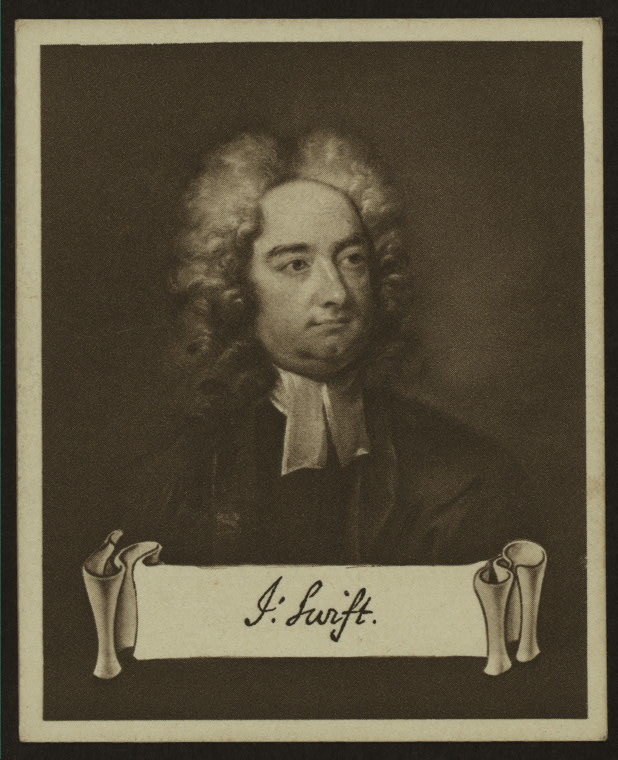Biblio File
Happy All Knaves' Day

But death - especially immediate death - is never as entertaining as a good crippling.
In 1708, the Irish satirist Jonathan Swift executed a multi-part media hoax against the astrologer and almanac-maker John Partridge, and although Swift didn't kill him directly, he certainly succeeded in making, as he called it, "sin and folly bleed." Swift disliked Partridge, claiming he was a quack whose almanacs purported to scientifically predict the events of the coming year. He also hated him for writing propaganda against the Anglican Church, in which Swift was an ordained priest.
Almanacs were an important part of eighteenth-century life. They contained a daily calendar and list of scheduled events and holidays for the year, maxims and proverbs, weather and tide predictions, as well as astrological information. Sometimes, though, the almanac-makers just made stuff up - their own ideological biases informed their predictions for the folly and fall of kings and nations.
Swift, using the pen name Isaac Bickerstaff, decided to publish his own Predictions for the Year 1708 as a penny pamphlet in response to such almanac-makers as Partridge, with the explicit intention "to prevent People from being further Impos'd on by vulgar Almanack Makers." In his pamphlet, Swift predicted John Partridge would die on March 19th "of a raging fever." The Predictions became so popular they spurned unauthorized editions outside the U.K., and Partridge responded to his imminent death with a public rebuttal entitled Mr. Partridge's Answer to Esquire Bickerstaff's Strange and Wonderful Predictions for the Year 1708, in which he accused Bickerstaff of being a Jacobite. But Swift would not be stopped, and at the end of March he published an anonymous letter describing the accomplishments of Bickerstaff's predictions so far, including an affirmation of Mr. Partridge's death, as well as a broadside elegy and epitaph for the "cobbler, Starmonger, and Quack." Poor Partridge insisted in print that he was still alive, but as April progressed, Swift's joke had caught on with contemporary writers, who collaborated in print to keep Partridge dead.
 The literary critic George P. Mayhew argues that Swift's joke on Partridge was intended as an April Fools' joke - Swift loved All Fools' Day - even though the joke continued well into April and into the year 1712. But Swift also privately referred to April 2nd as All Knaves' Day - "those fools and knaves, against whose republic I have always been at open war" - and this story is my favorite All Knaves' Day story.
The literary critic George P. Mayhew argues that Swift's joke on Partridge was intended as an April Fools' joke - Swift loved All Fools' Day - even though the joke continued well into April and into the year 1712. But Swift also privately referred to April 2nd as All Knaves' Day - "those fools and knaves, against whose republic I have always been at open war" - and this story is my favorite All Knaves' Day story.
If you'd like to read more about the fools and knaves of eighteenth-century U.K., or you just like eighteenth-century "media," access the original books, broadsides, and pamphlets in our full-text database Eighteenth Century Collections Online, available on-site at NYPL's research libraries.
Partridge's career as an astrologer and almanack-maker did not survive Swift's satire, even if Partridge did - to die in 1714.
Read E-Books with SimplyE
 With your library card, it's easier than ever to choose from more than 300,000 e-books on SimplyE, The New York Public Library's free e-reader app. Gain access to digital resources for all ages, including e-books, audiobooks, databases, and more.
With your library card, it's easier than ever to choose from more than 300,000 e-books on SimplyE, The New York Public Library's free e-reader app. Gain access to digital resources for all ages, including e-books, audiobooks, databases, and more.
If you don’t have an NYPL library card, New York State residents can apply for a digital card online or through SimplyE (available on the App Store or Google Play).
Need more help? Read our guide to using SimplyE.